 | Unofficial
Dragons Site

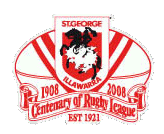 EST 1921
EST 1921
| | |
 |
DRAGONS
HISTORY The St George
Illawarra Dragons Football Club
Since
1921 Our Proud History
|
| | MILESTONES
Dragons milestone events | Some
pics can be clicked on for larger images | |
| THE
'DASH FOR THE DOOR'
Mid 1907: St George can trace it's Rugby League
history back to 1907 when the new game was first mentioned in local newspaper,
the St George Call. This was during the early days of Australia's breakaway
from Rugby Union with James Giltinan, Henry Hoyle and cricketer Victor Trumper
attending meetings in an effort to attract players to Rugby League.
Rockdale
Town Hall, Friday, February 28, 1908: A meeting was held at Rockdale Town
Hall, south of Sydney. Mainly instigated by St George Rugby League pioneers, Messers
W. Munn and Joe McGraw, the meeting was attended by New South Wales Rugby League
officials and Rugby Union players from the local district.
At this meeting,
a St George Rugby League club was definitely formed with chairman of the meeting,
Alderman and Mayor W. Taylor being elected as President. NSWRL chairman, Henry
Clement Hoyle delivered a convincing address and the Rugby Union players in attendance
unanimously voted in favour of joining the new Rugby League.
However, pressure
from Rugby Union saw a swift change of mind with only three players actually signing
up, one of those being Ted Courtney who later became a member of the first Kangaroos.
According to The Bulletin, in campaigning against the new game, there was
a hasty exit to the door. But other reports in The St George Call and The
Rugby League News painted a different picture, stating the meeting was well
attended and that the motion to form a League club in St George was carried. Nevertheless,
the end result was disappointment for the organisers and a new approach was required.
 Sans
Souci, April 30, 1910: It took two more years but in 1910, the "St George
Third Grade Rugby League Football Club" was formed and admitted into the
NSWRL third grade competition. Sans
Souci, April 30, 1910: It took two more years but in 1910, the "St George
Third Grade Rugby League Football Club" was formed and admitted into the
NSWRL third grade competition.
The colours of the club were red and white.
The jerseys had red and white horizontal hoops which were four inches wide. They
wore black shorts, black socks with red and white tops. The headquarters were
at Stroud's Hotel, Kogarah, and the training room was the small hall (old church)
in Gray Street. The club's home ground was at Sans Souci and Mr A. Farrat was
installed as coach.
The St George third graders of 1910 became the first
St George Rugby League team to take to the field and did so in convincing fashion,
thrashing the Newtown thirds by 36-0 at Sans Souci.
The scorers for this historic
match were: C Haydon 3, J Thomson 2, F Holt, B Haydon, A.Gore tries. C Haydon
4, A Larkin, S Territt goals. Referee: C Negus. |


Joe McGraw | | |
SAINTS' FIRST MATCH IN FIRST GRADE - 'ST GEORGES DAY', 1921
Sydney Sports Ground, Saturday, 23 April 1921: Kickoff: 3:15pm
Saints'
first match in the top grade was coincidentally scheduled for 'St George's Day',
1921. Their opponents were Glebe, captained by William 'Binghi' Benson who went
on to play for Saints in 1927 and featured the mighty Frank 'Chunky' Burge who
would later captain-coach St George.
Herb Gilbert Snr had the honour of being
the inaugural first grade captain and coach. A veteran of 33 years old, Gilbert
was regarded as one of the greatest centres in the game. His inspiration and experience
brought instant respect to the new club.
Saints went down 4-3 but kept the
more fancied Glebe tryless. A standout player for St George was forward, Ernie
Lapham who out-performed his rivals.
Centre George 'Bluey' Carstairs had the
honour of scoring Saints' first ever try. Carstairs also has the honour of being
the first junior from the St George district to be selected for Australia, playing
in two Tests on the 1921-22 Kangaroo tour.
The inaugural FIRST GRADE TEAM on the day (with
numbers)
Fullback:1- Lyall Wall.
Wing three quarters: 2- George 'Bluey'
Carstairs; 5- Norman Shadlow.
Centre three quarters: 3- Herb Gilbert (captain-coach);
4- Reg Fusedale.
Halves: 8- Tommy Burns; 9- Frank Gray.
Forwards: 10-
Clarrie Tye; 11- Roy 'Bunny' Bossi; 12- Tony Redmond; 13- Ernie 'Curly' Lapham;
14- Sid Field; 15- Jack Clark.Reserves: 6- Lew Heuschkel; 7- A. Bossi, 16- F 'Skinny'
Wilkins; 17- J. Morris | For more about the events which led
to the formation of the Dragons and the early years, click on the links below:
| 1907-1920
| 1921-1925
| | 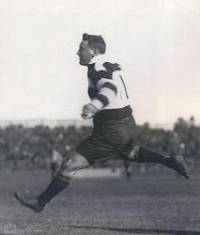 George Carstairs
George Carstairs | | | SAINTS
FIND HOME AT EARL PARK
Earl Park, Arncliffe, 16 May 1925:
Since joining the first grade, Saints were without a true home ground. Hurstville
Oval was not an acceptable football ground and the search was on for somewhere
suitable.
In 1925, St George found a home at Earl Park in Arncliffe and it
soon became a popular venue for the growing St George support base.
Their
first game at Earl Park on May 16th was in front of 5,000 people who came to see
Saints defeat Wests 6 - 5, Saints scoring two tries to one. The referee was W.
Neill.
St George had a great year at Earl Park also defeating University (twice)
and Easts. Saints only loss at Earl in 1925 was to eventual premiers, Souths in
a tight match which saw Saints score two tries to one but go down 11-10 in front
of 8000 people. | 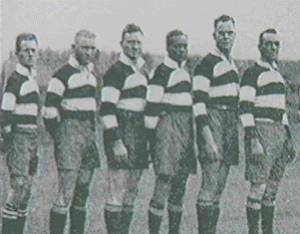 |
| | ST
GEORGE MAKE FINAL FOR FIRST TIME
Royal Agricultural Showground, 17
September 1927: After defeating Easts 26-11 in the minor semi-final, St George
had qualified for their first ever final in their first ever semis.
Saints
eventually went down 20-11 to minor premiers, South Sydney. But it was a tremendous
turnaround for the red and whites who, under the guidance of Frank Burge, had
gone from wooden spooners to runners up in just one season.
Playing on a quagmire,
Saints confronted the might of Souths in the final at the RAS in front of 12,124
people. The two teams had already met earlier in the season at the Sydney Cricket
Ground when Souths defeated Saints 17-14 in front of a massive crowd of 31,500.
With heavy rain falling throughout the match, Souths won the decider scoring four
tries to three.
Full time
Souths 20 (4 tries, 4 goals) defeated
St George 11 (3 tries, 1 goal).
Scorers for St George
Tries: Arthur
'Snowy'. Justice, George Carstairs, Frank 'Fatty' Saunders. Goals: Frank Saunders.
Crowd: 8,000. Referee: W. Neill. | 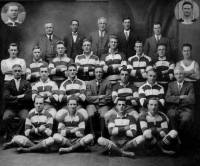
The 1927 runners up | |
|
THE
EARL PARK RIOT
Earl Park, 11 August 1928: In a firey match,
St George have defeated Balmain 21-3 in front of 6000 people. But the match will
remembered for an all-in brawl which turned into a riot with spectators getting
involved. Police intervened using hand cuffs, batons and fists in an effort to
quell what has been dubbed, 'the Earl Park riot'.
It appears the source of
the crowd's aggravation began when referee Brannaghan sent off St George forward
Harry Flower early in the second half, but allowed Balmain players to stay on
the field. Meanwhile, there was plenty of niggle going on amidst claims that St
George centre George Carstairs delivered a raised elbow to Balmain forward Tony
Russell.
Five minutes from fulltime, St George players retaliated when Carstairs
was stomped on the head by Russell. Earlier, Carstairs had been kicked in the
face while playing the ball but on this occasion he was knocked unconscious. Brannaghan's
decision to only cautioned Russell brought a strong reaction from players, officials,
and the crowd.
Following an on-field brawl, St George coach, Frank Burgh and
secretary, Reg Fusedale approached Brannaghan for an explanation. The game continued
but another incident at fulltime escalated the already volatile situation.
With the match over, Balmain's George Bishop decided to settle a few old scores
and began chasing St George five eighth, Arnold Traynor from the field. This infuriated
sections of the crowd and hundreds invaded the pitch with the intention of seeking
their own revenge. Supporters used fence palings for weapons and one witness reported
seeing a man running around behind the grandstand with an axe!
Former St George
official Glynn Price was 15 at the time and an eye-witness to the Earl Park riot.
He later recalled going home for his dinner and came back later to find the fighting
still going on.
Police eventually restored order but not before Russell was
badly beaten by the crowd. He suffered leg and head injuries and was put into
the same ambulance as George Carstairs where it was reported that he leapt up
and attacked Carstairs. Ambulance officers had to intervene to restrain Russell.
A week later, a NSWRL investigation blamed crowd violence and not the players
or officials for the disturbance.
ST GEORGE MINOR PREMIERS
FOR FIRST TIME
Sydney Cricket Ground, 1 September 1928:
The St George 'Dragon Slayers' have secured top position on the ladder after defeating
Norths 23-13 in the final round of the minor premiership. Saints were equal with
Easts on 28 points but attain top spot by virtue of a better for-and-against.
Additionally, Easts had two byes to St George's one bye. Saints had a tremendous
season in 1928, losing just one match and posting 12 wins, including a 24-0 drubbing
of Glebe.
St George went into the semis with the knowledge that throughout
1928, they had the better of the other three semi-finalists, Easts, Souths and
Norths. The following week however, Souths defeated St George 13-5 in the 'sudden
death' major semi final at Earl Park in front of a crowd
of 14,758. |
QUOTE:
Inside the ambulance the ruckus started again with
Russell attacking Carstairs with the words: "You started this, you bastard
... now I'm going to finish it." Ambulance men had to pull the two warring
players apart in the ambulance.
- From the Book"Tiger, Tiger, Burning
Bright" by Ray Chesterton |
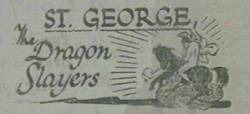 |
| | SAINTS
WIN FINAL BUT MINOR PREMIERS GET SECOND CHANCE
Sydney Sports Ground,
27 September 1930: The St George Dragon Slayers, positioned 4th on the ladder
have hit form at the right end of the season with two remarkable semi-final wins.
The first victory being over Eastern Suburbs 11-10 at Earl Park on September 20.
Saints then continued their good form into the following weekend when in the final,
they defeated minor premiers Western Suburbs 14-6 in front of 16,557 people.
The two teams have met twice before during the season with Wests winning the first
encounter in May and St George winning the second match in August.
Under the
previous system, the victory in the final would have seen Saints declared premiership
champions. But in 1930, the minor premiers, Wests were allowed a second chance
if defeated during the finals.
Sydney Sports Ground, 4 October 1930:
In what looks more like a return match, the 'Grand Final' of 1930 was decided
in front of 12,178 people.
Saints led 2-0 early on and competed well in the
first half. But Wests were a crack outfit and they skipped away to a 16-2 as Saints
lost veteran forward, Harry Flower with an arm injury. Wests went on to defeat
St George 27-2. | 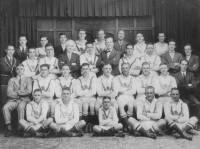 The 1930 runners up
The 1930 runners up | | | SAINTS
ANNIHILATE CANTERBURY 91 - 6
'EARL PARK MASSACRE' AN HISTORIC WIN
Earl Park, 11 May 1935: Saints delivered a stunning footballing lesson to
competition newcomers, Canterbury - Bankstown when they posted a record premiership
win of 91-6 (NB: this equates to 110-6 on modern scoring). One can but imagine
what was going through the minds of the slaughtered as they came to terms with
a premiership loss that in all likelihood, will never be surpassed.
Canterbury
opened the scoring with two goals from the boot of Carey and led 4-0. But St George
cut loose, running up a half time lead of 21-6. Saints' line was never crossed
and by full time, as they scored 19 tries and 17 goals as every player in the
team made it onto the scorecard.
St George winger, Les Griffin posted a club
record for most points and goals scored in a first grade match when he posted
36 points (2 tries, 15 goals). This 36 points record only being equalled in 1947
by Jack Lindwall.
(NB: Griffin's and Lindwall's record stood as an all-grade
club record. But this was broken decades later when third grader Wes Naiqama score
38 points in a Jersey Flegg match in 2002).
Les's record of 15 goals in one
match still stands not only as a club record but it is also a competition record
held jointly with Easts' Dave Brown.
Scorers for St George
Tries:
Max Hollingsworth 4, Len Kelly 3, Les Griffin 2, Percy Fairall 2, Jim Rutherford
2, J. Flower, P. White, Bill 'Wombo' Killiby, Eddie Root, Charlie 'Chikker' Rice,
Fred 'Yappy' Gardner. Goals: Les Griffin 15, Stan Robinson, Jack Lynch.
Referee:
J. Murphy. |
ST GEORGE, 11 May 1935
(vs Canterbury)
Fullback
S. Robinson
Three Quarters
F. Gardner L.
Griffin
M. Hollingsworth J. Lynch
Halves
J. Flower
P. White
Forwards
W.
Killiby
C. Rice J. Rutherford
L. Kelly E. Root
P.
Fairall (c) | | |
| ST
GEORGE WIN FIRST PREMIERSHIP
Sydney Cricket Ground, 30 August 1941:
Following 20 years of persistence and near misses, St George finally win their
first premiership. From 1921 to 1941, St George have been Club Champions and Minor
Premiers. They have been runners-up three times and in a period when semi-finals
were not always played, Saints qualified for the play-offs no less than 10 times.
But the premiership had eluded them. That is, until 1941.
After 14 rounds
Saints were in 4th position on 17 pts but were only one point behind Easts, Balmain
and Canterbury. Supporters were ruing the round nine match when Saints scored
two tries to one but went down to Canterbury 15-14, thus ultimately denying the
Dragons the minor premiership. But with by far the best season attacking record
(63 tries) Saints made easy work of Balmain in the minor semi-final, winning 32-8.
The Dragons then went on to win the greatest prize of all when they trounced Easts
in the Final 31-14, in front of 39,957 people.
In what was a tough encounter,
St George captain-coach and star player, Neville Smith was knocked out after a
heavy tackle early in the match. In another incident, Easts forward, Jack Arnold
and Saints forward, Bill Tyquin were sent off after an almighty punch up.
Neville Smith recovered and scored 13 points with one try and five goals. In 1939,
Neville came to St George from Valleys (Brisbane) and became the youngest ever
captain-coach in the club's history.
Scorers for St George
Tries:
Roy 'Torchy' Hasson (halfback) 2, Owen 'Bricky' Campbell (winger) 2, Neville Smith
(captain-coach), Gordon Hart (winger), Len 'Deacon' Kelly (forward).
Goals:
Neville Smith 5.
Crowd: 39,957. Referee: Tom McMahon. |
 1941 premiers
1941 premiers | | |
CLUB CHAMPIONS AND GRAND FINALISTS IN ALL THREE GRADES
Saints were runaway Club Champions in 1942 and all three grades made
it to Grand Final in 1942 with the Third Grade being victorious.
LATE
GOAL SAVES CANTERBURY-BANKSTOWN
Sydney Cricket Ground, 12 September
1942: It was a tight Grand Final with both teams scoring one try each, Canterbury's
Lindsay Johnson managed a late conversion to secure a 11-9 victory over St George.
Saints were leading 9-6 late in the match but a Canterbury try locked up the scores
at 9-all The Canterbury fullback's goal just scraped over the cross bar giving
his team the premiership.
The Grand Final was a muddy affair. Brothers Jack
and Ray Lindwall featured heavily with Jack scoring a try and Ray kicking three
goals.
In the previous weeks, Saints had already beaten Canterbury 25-10
on August 22. Saints also won the Preliminary Final, defeating Easts 18-5 which
normally would have declared Saints as being the Premiers.
But under a call
back to rules previously deemed unworkable in the the 1930s Saints had to play
the minor premiers, Canterbury again in the Grand Final. A revision of the system
showed that it did have some merits but it is clear that extra games meant extra
gate money.
Coming into the premiership decider, Saints had won two matches
in the semis. Minor premiers Canterbury had just one victory but were always guaranteed
a grand final berth.
Scorers for St George
Tries: Jack Lindwall.
Goals: Ray Lindwall 3.
Crowd: 26,171. Referee: J. O'Brien. |
 Jack Lindwall
Jack Lindwall | | | DRAGONS
CLUB CHAMPIONS, MINOR PREMIERS & GRAND FINALISTS
'Robbed' in contentious
Grand Final
Sydney Sports Ground, 14 September 1946: In typical
fashion, St George have bounced back from the lower end of the ladder to finish
the 1946 season as minor premiers. As well, Saints performed well in all grades,
claiming the club championship.
In a highly controversial Grand Final, Balmain
narrowly defeated St George 13-12 following a series of decisions by referee George
Bishop which according to observers, gave Balmain numerous advantages. In particular,
two Balmain tries came from forward passes and there was a disallowed try to St
George. Bishop's refereeing was described as 'astounding' when Balmain's Joe Jorgenson
scored after receiving a ball that was propelled a yard forward.
Despite
this, Saints came within a whisker of victory when Jack Lindwall scored in the
corner but brother Ray Lindwall, in his last match for Saints, was unable to convert
in the difficult conditions. In fact, Ray Lindwall was unable to land any conversions
throughout the match and Saints were defeated despite scoring four tries to three.
Once rated the best full back in the game, Ray Lindwall was also Australia's strike
bowler on the 1948 Ashes Tour to England with Don Bradman's Invincibles. Lindwall
went on to take 228 wickets in 61 Tests. With the bat, Lindwall scored two Test
centuries and five half centuries with a high score of 118.
Scorers for
St George
Tries: Jack Lindwall 2, Noel Jones, Jack Munn. Goals: Ray Lindwall
0/4. Crowd: 32,296. Referee: G Bishop.
Poste script: Tensions of the
encounter overflowed after fulltime and the match concluded on an ugly note when
Saints forward, Jim Hale went toe to toe with Balmain hooker, Herb Gilbert Jnr.
Hale was then attacked by a spectator and an all-in brawl followed. This incident
has been rated as contentious as the Earl Park riot of 1928. |
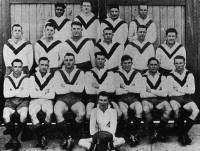
1946 minor premiers & runners-up | |
| ST
GEORGE CLAIM SECOND PREMIERSHIP
Sydney Cricket Ground, 10 September
1949: In a brutal encounter, the St George Dragons ran in five tries and overcame
South Sydney 19-12 to claim the 1949 premiership in front of 56,534 people.
Coming into the semis, Saints finished 3rd on the ladder (23 pts) after 18 rounds
of football. To get the Grand Final, Saints first defeated minor premiers Souths
in the major semi-final 16-12 (August 20), and then Balmain in the preliminary
final 18-7 (September 3).
In the Grand Final, St George were led masterfully
by their victorious captain, Norman 'Johnny' Hawke. Controlling all aspects of
the match, Hawke took the game away from Souths who only got back into the contest
when Hawke was forced from the field with injury. Also injured was forward, George
Jardine who played the match with a broken wrist.
After some treatment, Hawke
returned to the field and set up the play for victory. 'Johnny' Hawke was dubbed
'man of the match' and 'the player's player' in a team of stars which included
the season's leading try scorer (25 tries) and newcomer, Ron Roberts and Noel
Pidding. Both wingers scored two tries each.
FULLTIME: ST GEORGE 19 defeated
SOUTH SYDNEY 12.
Dragons first grade coach for 1949: Jim Duckworth
Scorers
for St George
Tries: Ron Roberts 2, Noel Pidding 2, Matt McCoy. Goals:
Matt McCoy, Noel Pidding.
Crowd: 56,534. Referee: G. Bishop. |
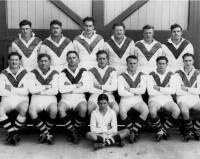 1949 premiers
1949 premiers | | | NEW
HOME GROUND AT KOGARAH
In 1950, Saints left Hurstville Oval and
moved to Kogarah Jubilee Oval. This was to prove a major turning point in the
history of the club.
From 1954 -1966, St George had a winning streak at Kogarah
which lasted a mind staggering 13 years. From 1950-1999, St George enjoyed a 70%
success rate at Kogarah, winning 256 of their 371 games.
Koagarah Jubilee
Oval is part of a grant of 87 acres given to Archibald McNab in 1853. This was
purchased by Edmund English in 1854 before becoming known as Kogarah Park when
acquired by the Department of Lands in 1896. In 1906, the Council of the Municipality
of Kogarah took over control of the park.
In 1935, as part of Kogarah's Jubilee
celebrations, an oval was built and named Kogarah Jubilee Oval. St George played
a one-off exhibition match there in 1936, defeating Newtown. The gate takings
were donated to St George Hospital.
In 1963, St George Leagues Club was built
almost opposite Kogarah Jubilee Oval, contributing to the dominance of the football
club during this period.
In 1986, Saints started playing their 'home' games
at other venues while work began on the western grandstand. St George failed to
make the semi finals for the next three seasons while Kogarah was being refurbished.
In 1999, a joint venture arrangement with Illawarra saw home games being shared
between Kogarah and Wollongong. But Kogarah failed to meet the home ground criteria
set down by the National Rugby League and in 2000, the Dragons left Kogarah altogether.
Intense lobbying from supporter's group R2K, as well support from within the club
itself, saw the Dragons return to Kogarah in 2003, sharing home games with Wollongong.
In 2004 it was announced that an $8 million government grant would be put into
upgrading Jubilee with additional seating and lighting.
|
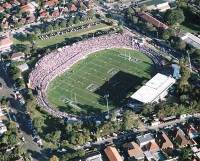 Kogarah Jubilee Oval
Kogarah Jubilee Oval | |
| THE
GOLDEN YEARS
Sydney Cricket Ground, 8 September 1956: Playing
with just 12 men, St George defeated a determined Tigers outfit 18-12 to win the
1956 Grand Final.
The 1956 premiership victory saw the beginning of one the
greatest winning streaks in recorded history.
The St George Dragons cemented
themselves as one of the world's greatest sporting clubs when they won an unprecedented
11 straight premierships between 1956-1966. Immortals such as Graeme Langlands,
John Raper and Reg Gasnier were just a few of the greats who wore the red V during
these golden years.
In addition, St George won the minor premiership consistently
over a 12 year period (1956-1967) with the only exception being 1961 when the
NSWRL split the minor premiership prize money between Saints and Wests.
In
1959 St George went through the season undefeated. Strong in all grades, Saints
won a number of club championships and in 1963, were premiers in all three grades;
the Thirds defeating Canterbury 12-2, the Reserves defeating Souths 5-4 and the.
First Grade defeating Wests 8-3.
In a changing game which included the introduction
of limited tackled football, the run of premierships finally came to an end when
Saints were defeated in the 1967 preliminary final. But there remained a legacy
which would see the Dragons continue to feature as premiership contenders for
years to come.
SUMMARY
| Year |
Result | Scorers
for St George | SCG crowd,
referee | | 1956 | Saints
18
Balmain 12 | Kevin O'Brien, Bob Bugden, Kevin Brown,
Harry Melville tries. Doug Fleming 3 goals. | 61,987
D.
Lawler | | 1957 | Saints 31
Manly
9 | Brian Clay 2, Tommy Ryan, Jack Fifield, Eddie Lumsden tries.
Harry Bath 8 goals. | 54,399
D. Lawler | | 1958 | Saints
20
Wests 9 | Norm Provan 2, Bob Bugden, Eddie Lumsden tries.
Harry Bath 4 goals. | 62,283
D. Lawler | | 1959 | Saints
20
Manly 0 | Eddie Lumsden 3, Brian Graham, Geoff Weekes,
Norm Provan tries. Harry Bath goal. | 49,457
D Lawler |
| 1960 | Saints 31
Easts 6 | Reg
Gasnier 2, Johnny King 2, Bob Bugden, Dave Brown, Norm Provan tries. Brian Graham
5 goals. | 53,156
D. Lawler | | 1961 | Saints
22
Wests 0 | Eddie Lumsden 3, Johnny King tries. Brian Graham
5 goals. | 61,196
D. Lawler | | 1962 | Saints
9
Wests 6 | Johnny King try. Kevin McDonald 3 goals. | 41,184
D. Lawler | | 1963 | Saints 8
Wests 3 | George Evans, Johnny King tries. Reg Gasnier goal. | 69,860
D. Lawler | | 1964 | Saints 11
Balmain 6 | Johnny King try. Graeme Langlands 4 goals. | 61,369
C. Pearce | | 1965 | Saints 12
Souths 8 | Billy Smith, Johnny King tries. Graeme Langlands
3 goals. | 78,056
C. Pearce | | 1966 | Saints
23
Balmain 4 | Bruce Pollard, Dick Huddart, Kevin Ryan tries.
Graeme Langlands 7 goals. | 61,129
C. Pearce | 222
Matches 1956-1966: Wins 183, Losses 34, Draws 5
Total points for: 5109
(average 23.01 / match). Total points against: 2153 (average 9.70 / match).
For more about the Golden Years, click on the links below:
| 1956-1959
| 1960-1963
| 1964-1966
| | 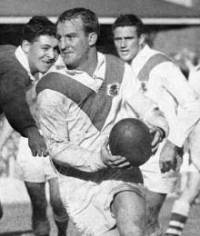 John Raper
John Raper | | | SAINTS
RATED UNDERDOGS IN '71 GRAND FINAL
Sydney Cricket Ground, 18
September 1971: In season 1971, St George qualified for the semi-finals for
the 21st season in succession finishing third on the ladder and were eventual
runners up. The Dragon's march to the Grand Final came at the expense of Parramatta
19-8 (28 Aug) and Manly 15-12 (11 Sep).
Saints went into the Grand Final against
Souths as underdogs. Souths had a larger pack and the St George team, captained
by Graeme Langlands was a much younger side.
The first half was gruelling
affair with the only score coming from an Eric Simms' field goal. At half time
Souths were in front by the unlikely scoreline of 1-0.
Souths raced ahead
in the second half and at one stage, held an 11-nil lead. But the Dragons fought
back with tries to Barry Beath and Ted Walton. Langlands adding the extras which
included a magnificent conversion from the touchline.
At 11-10 and with only
12 minutes remaining Saints looked to be getting on top of their more fancied
rivals. But the experience of Souths won out when they eventually defeated Saints
16-10 thanks to a match winning try from Bob McCarthy.
In the end, it was
desperately close match and has been rated as one of the greatest grand finals
ever played.
Fulltime 1971 grand final: South Sydney Rabbitohs 16 defeated
St George 10.
Scorers for St George
Tries: Beath, Walton tries.
Goals: Langlands 2.
Crowd: 62,838. Referee: K Holman.
|
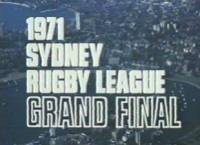
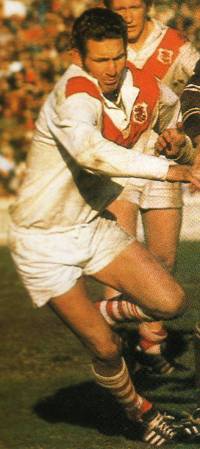 Graeme Langlands
Graeme Langlands | | | 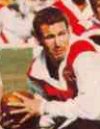 LANGLANDS
RETIRES LANGLANDS
RETIRES
April 1976: Graeme 'Changa' Langlands has announced his
retirement from Rugby League. The champion full back returned for one more season
in 1976 but after four rounds, he decided to call it a day.
Originally signed
from Wollongong, Langlands' contract was bought for £3000 following a previous
offer of £1000 up front plus £1000 every time 'Changa' played an international.
This offer was rejected by Wollongong. History shows that Langlands played for
Australia no less than 90 times.
For a generation, 'Chang' entertained Rugby
League crowds with spectacular footballing feats at club, state and international
level. He played in four consecutive Grand Final wins for St George.
In later
years, Graeme Langlands would be awarded an MBE and in 1999, he would be named
as a 'Rugby League Immortal'.
Perhaps one of the greatest honours a player
can receive is that which is bestowed upon him by his peers. In 1985, Rugby
League Week arranged an Australian team reunion. Entitled, 'The Masters',
it included 'the 13 best players' since 1970. Amongst them were no less than eight
former Australian captains, including Graeme Langlands. When it came to the 'team
photo', Chang was late to take his seat. In the end, there was only one spot left,
the one in the centre of the front row and the position reserved for the team
captain. Chang's peers had spontaneously and unanimously decided that the captain's
spot for this legendary team belonged to Graeme Langlands.
Chang's
stats:
ST GEORGE DRAGONS
1963-1976: 227 games
86 tries, 648 goals,
1554 points.
Domestic Rep honours:
Country firsts 1962 (1 match),
City 2nds 1963-65 (2 matches),
City firsts 1967-73 (6 matches),
Sydney 1964-66, (2 matches: internationals),
NSW 1962-75 (36 matches: 33
vs Qld + 3 internationals).
Australian Rep honours:
Tests 1963-74
(34 matches),
World Cup (11 matches),
Tour matches 1963-75 (45 matches).
In all, Graeme Langlands played 320 top level matches scoring 132 tries,
866 goals for a first class career total of 2128 points. |
CHANGA'S WHITE BOOTS WHITEWASH
 Sydney
Cricket Ground, 20 September 1975: The white boots worn by Graeme 'Changa'
Langlands in the 1975 grand final have become part of rugby league folklore. Former
Kangaroo winger, Ken Irvine worked for Adidas and gave the promotional boots to
his mate Langlands. In a time when all football boots were black, the white boots
were as innovative as they were eye-catching. For Saints supporters the novelty
soon turned into disaster with the white boots remaining as a painful reminder
of a great player struggling in the most important match of the year; and the
38-0 thrashing which followed. Sydney
Cricket Ground, 20 September 1975: The white boots worn by Graeme 'Changa'
Langlands in the 1975 grand final have become part of rugby league folklore. Former
Kangaroo winger, Ken Irvine worked for Adidas and gave the promotional boots to
his mate Langlands. In a time when all football boots were black, the white boots
were as innovative as they were eye-catching. For Saints supporters the novelty
soon turned into disaster with the white boots remaining as a painful reminder
of a great player struggling in the most important match of the year; and the
38-0 thrashing which followed.
Coached by Jack Gibson, the Roosters led 5-0
at half time. The hot favourites carved up the Dragons in second half, posting
a record score for a Grand Final.
But Chang's white boots weren't to blame.
Prior to kick-off, Langlands had a painkilling injection to deal with a groin
injury. The injection went wrong and he lost feeling in one of his legs. Uncoordinated,
'Chang' became a passenger in the backline and his famous side-step and kicking
game deserted him. Thus, the white boots served as a symbol to the worst day imaginable
for the footballing legend.
Langlands kept the boots and took them to England
where he was coaching Australia in the World Series.
While in Yorkshire and
after a training session, 'Changa' decided to throw the boots over a cross bar
and that was the last he ever saw of them. Langlands may have ditched the white
boots on an impulse but years later, the Rugby League Immortal said he wish he
kept them when he quipped, "they'd be worth a fortune now." |
| | | 'THE
GAME OF THE CENTURY'
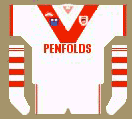 Sydney
Cricket Ground, 17 September 1977: Geoff Greenwood's, 'Australian Rugby League's
Greatest Games' described the first 1977 Grand Final between the St George Dragons
and the Parramatta Eels as being 'The Game of the Century'. Sydney
Cricket Ground, 17 September 1977: Geoff Greenwood's, 'Australian Rugby League's
Greatest Games' described the first 1977 Grand Final between the St George Dragons
and the Parramatta Eels as being 'The Game of the Century'.
Dubbed, 'Baths
Babes' after their coach Harry Bath, the Dragons were deemed too inexperienced
to roll over the Eels. Initially, the punters agreed but in the days prior to
the Grand Final, the betting market narrowed.
Frank Hyde, Rugby League veteran
and doyen of the airways, couldn't pick a winner. In one of his regular media
announcements, Frank exclaimed, "I wouldn't be surprised if this match finished
in a draw".
History shows that Saints led 9-0 at half time before Parramatta
came back to equalise, the scores locked up at 9-all after 80 minutes. Extra time
was called and after 100 minutes of gruelling football, the scoreboard remained
at 9-all. For the first time in the history of the competition, the premiership
was undecided. Minutes after the final whistle, the SCG ground announcer declared
that the teams would have the meet the following week for an historic grand final
replay.
Fulltime score (after extra time):
St George 9 (Goodwin
try. Goodwin 2, Chapman goals) drew with Parramatta 9 (Sulkowicz try, Cronin 3
goals).
Crowd: 65,959. Referee: G Cook. Full
match report: click here.
SAINTS UNSTOPPABLE IN GRAND
FINAL REPLAY
Sydney Cricket Ground, 24 September 1977: The Dragons,
with Craig Young and Steve Edge in the pack and coached by 'the old fox', Harry
Bath have won the Grand Final Replay with a resounding 22-0 victory over the Parramatta
Eels.
With a strong breeze at their backs, Saints began the match in determined
fashion, taking a 7-0 lead with a try to John Jansen following a great forward
charge by tireless front rower, Bruce Starkey. Saints went further ahead in the
second half with a with a penalty goal to Ted Goodwin. 'Lord Ted' was magical,
often injecting himself into the backline on the foundations built by a strong
forward pack and assisted by lock, Rod Reddy who was ruthless throughout the match
and experienced 2nd rower, Barry Beath. Goodwin then kicked a field goal to the
score to 10-0 before Robert Stone found the ball and ran some 30 metres score
an unbelievable forward's try.
Following a wonderful display of backing up,
Saints were awarded a penalty try by ref, Gary Cook, when John Bailey was taken
out by the tired defence. Goodwin successfully negotiated the conversion attempt
and at fulltime, St George had thrashed Parramatta 22-0 to win their 14th premiership.
After 180 minutes of bone-crushing football, Saints were finally declared the
champions of 1977.
Scorers for St George
Tries: John Jansen, Robert
Stone, John Bailey. Goals: Ted Goodwin 6. Field Goals: Ted Goodwin 1.
Crowd:
48,828. Referee: G Cook. |  1977 premiers
1977 premiers 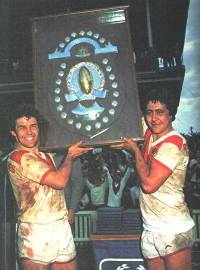
Steve Edge & Ted Goodwin | |
| SAINTS
WIN 15th PREMIERSHIP
Sydney Cricket Ground, 17 September 1979:
St George capped off a magnificent year, defeating Canterbury 17-13 in the 1979
Grand Final. After 22 rounds Saints were declared minor premiers, finishing on
34 points, two points clear of Parramatta. The Grand Final was played in fine
conditions with plenty of talk surrounding the rivalry between the opposing halfbacks,
the Dragons' Steve Morris and Canterbury's Steve Mortimer.
The half belonged
to Saints with fullback, Brian Johnson taking a pass 10 metres out from the Canterbury
line and scoring an easy opening try. Saints scored their second try when winger
Mitch Brennan ventured infield before being put through a gap by centre Robert
Finch. Then Morris put back rower Graeme Wynn into a gap. Wynn ran 40 metres pushing
defenders aside and leaving many of them in his wake. Then Morris, Wynn and 'Rocket'
Rod Reddy combined down the right flank to break the back of Canterbury with a
movement which began on halfway. 'Rocket' handled twice to score a try under the
posts.
At half time, it was Saints 17 - Canterbury 2.
Canterbury fought
back to score three tries with Steve Gearin and Peter Mortimer crossing. Stan
Cutler scored a late try out wide but by then it was all over. Saints can be grateful
for the kicking boots of prop forward, George Grant who scored 211 points in 1979
including four goals for Saints in the Grand Final, thereby ensuring the Dragons
of their 15th premiership victory. The Best Player Award ('Dave Brown Medal')
went to Steve Morris.
Scorers for St George
Tries: Brian Johnson,
Mitch Brennan, Rod Reddy. Goals: George Grant 4
Crowd: 50,991. Referee: G
Hartley. | 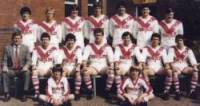 1979 premiers
1979 premiers | | | ILLAWARRA
STEELERS JOIN '82 COMP
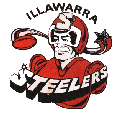 WIN
Stadium, 28 February 1982: In a move that was long overdue, a Southern Division
team was at last admitted into the Sydney competition. The 'Illawarra Steelers'
played their first ever first grade match against the Penrith Panthers, the referee
was Mick Stone. Playing at home in front of 9,652 spectators, the Steelers were
defeated 17-7 by Penrith with the Panthers scoring three tries to one. Prop forward
Greg Cook has the honour of scoring the first ever try for the Steelers. WIN
Stadium, 28 February 1982: In a move that was long overdue, a Southern Division
team was at last admitted into the Sydney competition. The 'Illawarra Steelers'
played their first ever first grade match against the Penrith Panthers, the referee
was Mick Stone. Playing at home in front of 9,652 spectators, the Steelers were
defeated 17-7 by Penrith with the Panthers scoring three tries to one. Prop forward
Greg Cook has the honour of scoring the first ever try for the Steelers.
By
comparison, other newcomers, Canberra were thrashed 37-7 in their first match
against Souths.
The inaugural Illawarra First Grade team was: John Sparks;
Shane McKellar; John Dorahy (c); Brian Hetherington; Chris Montgomery; Lee Pomfret;
Steve Topper; Marty Cavill; Wayne Springall; Rod Henniker; Peter Ryan; Barry Jenson
and Greg Cook.
The coach was Allan Fitzgibbon from Dapto.
|
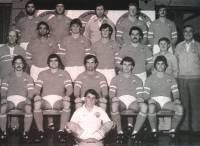 Illawarra Steelers 1982
Illawarra Steelers 1982 | |
| ST
GEORGE MINOR PREMIERS & GRAND FINALISTS
Sydney Cricket Ground,
29 September 1985: St George have been narrowly beaten 7-6 by Canterbury in
the 1985 Grand Final in front of 44,569 people.
In 1985, Saints were seeing
a resurgence and were minor premiers in all three grades with most players being
local juniors.
Earlier in the year, St George & Canterbury played a 10-all
draw in round six at Belmore (21Apr) and in round 19, St George had defeated Canterbury
16-6 at the SCG (14 July). Saints defeated Canterbury again in the major semi
final (15Sep) by 17-6 and on Grand Final day, Saints were favourites to win their
16th premiership.
Canterbury scored first with a try to winger, Peter Mortimer.
Brother, Steve Mortimer was instrumental in pinning St George down as the halfback
delivered a series of towering bombs onto the St George fullback, Glenn Burgess,
who never faltered.
But this effectively forced Saints into successive line
drop outs. The following year, the rule would be modified to allow a 20 metre
tap re-start should the defender catch the ball on the full. Canterbury took full
advantage of this flaw in the rules of the day and increased their lead to 7-nil
following a field goal. Saints struck back with a try to Steve Morris which was
converted but Saints were unable to score again, Canterbury winning by the narrowest
of margins to take out the 1985 premiership.
Despite the loss, 1985 was a
tremendous year for the Dragons. All three grades made the Grand Final with both
the U/23s & Reserve grade winning their respective matches. The first graders
contained a balance of strength and speed with the likes of Craig Young, Graeme
Wynn and Pat Jarvis up front while centre Michael O'Connor was a robust attacker
in the backs providing great service wingers Steve Morris and Denis Kinchela. |
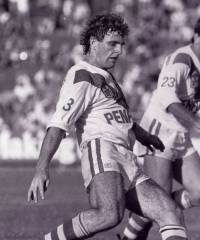 Michael O'Connor
Michael O'Connor | | | RUNNERS
UP TWO YEARS
ST GEORGE UNDERDOGS IN 1992 GRAND FINAL
Sydney Football
Stadium, 27 September 1992: Observers gave Saints little chance of making
the 1992 Grand Final but they did so in fine fashion under the guidance of coach,
Brian Smith. Saints did well in the first half but the star studded class of Brisbane
showed in the second half and they ran away winners to the tune of 28-8 in front
of 41,560 people.
Scorers for St George
Ricky Walford try, Ian
Herron 2 goals.
DRAGONS, BRONCOS IN GRAND FINAL AGAIN
Sydney Football Stadium, 26 September 1993: Saints were determined to
go one better in 1993 and came into the semis as the form team of the competition.
Their opponents, premiers Brisbane had a hard run into the semis and were beaten
by St George in the final round of the competition, 16-10 at QEII stadium in front
of 58,593 people thereby forcing the Broncos into the dreaded sudden death 5th
spot position.
In their run to the Grand Final, St George disposed of Canberra
31-10 (4Sep) and Canterbury 27-12 (12Sep). Brisbane won their three matches also
in convincing fashion but appeared to be struggling against Canterbury in the
latter stages of the preliminary final which suggested that they may have be succumbing
to rigors of elimination football.
The 1993 Grand Final, played in front
of 42,329 spectators will go down in history the day when Saints saved their worst
game of the year 'til last. Brisbane put on a huge defensive effort and slowed
down the game. Saints were unable to respond and eventually went down without
scoring a try.
Score: Brisbane 14-6.
Scorers for St George
Ian Herron 3 goals.
| 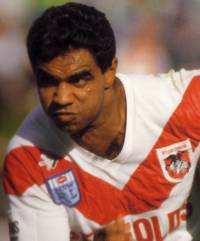 Ricky Walford
Ricky Walford | | | THE
FUTURE IN DOUBT & SUPER LEAGUE
Season 1996 will be remembered
by most supporters as a time when the club's very existence came into question
as coaching staff, players, sponsors, and officials turned their back on the mighty
Dragons. In basic terms, the new 'Super League' (backed by News Limited) and the
traditional Australian Rugby League found themselves in a fight over broadcasting
rights. But the fight went beyond money and greed as a bidding war began for playing
personnel. Contracts, along with friendships, were pushed aside. The game was
ultimately brought to its knees with the damaged being felt for years afterwards.
St George themselves were already recovering from another upheaval. Earlier, in
1995, merger talks between Saints and Easts saw a massive backlash by supporters
and changes to the administration became inevitable. Geoff Carr moved on and Brian
Johnston became the club's new CEO.
Meanwhile, coach Brian Smith quit St George
to take up a coaching job in the UK. Although it was an amicable decision, it
was clear that Smith was influenced by the uncertain climate and how it would
effect Saints' future.
In 1996, St George put their support behind the ARL
and NSWRL. Amidst the destruction, it appeared that the Dragons were being targeted.
Reports flowed from News Limited's publications that Saints were likely to become
casualties of the 'Super League War'.
What followed was a mass exodus of personnel.
First, new coach, Rod Reddy abandoned Saints with little notice after he was offered
a position with the proposed Super League franchise, the Adelaide Rams (Reddy
would later be sacked with the Rams' demise in 1998).
Matters worsened when
most of the playing squad gave notice that they were now training with other clubs
and the game was now being played out in the courts.
To top it off, St George's
long term sponsor, Penfolds announced that they were withdrawing their support.
Despite these hardships, St George recovered and the players came back as did
a new sponsor in Newmans. The board signed a new coach in David Waite who engineered
a remarkable comeback as Saints surprised everyone in making it to the 1996 Grand
Final.
A SEASON BEYOND EXPECTATIONS
Sydney Football
Stadium, 29 September 1996: Competition front runners, Manly have scored four
tries to one and defeated St George in the 1996 Grand Final. The turning point
happened just minutes before halftime when Manly fullback, Mathew Ridge grubbered
a short kick off, regathered the ball and appeared to be tackled by Nathan Brown.
However, referee David Manson allowed play to continue and a few moments later,
Manly's Steven Menzies scored under the posts. This gave Manly a half time lead
of 14-2.
In the second half, Saints and Manly scored one converted try each
with winger Nick Zisti crossing the rarely breached Manly line.
Scorers
ST GEORGE DRAGONS 8 (N Zisti try, W Bartrim 2/2 goals)
MANLY-WARRINGAH SEA
EAGLES 20 (C Innes, S Menzies, D Moore tries, M Ridge 3/3, C Innes 1/1goals).
Crowd 40,985 | 
Mark Coyne
QUOTE:
"In all the years that I played at the club,
'96 was my favourite because we came from absolutely nowhere to get to the Grand
Final. The feeling that we had leading up to that Grand Final was quite a strong
bond that I've never felt before."
- Mark Coyne (captain) |
| | | ST
GEORGE & ILLAWARRA CONFIRM THAT TEAMS WILL MERGE INTO A DRAGONS JOINT VENTURE
September 1998: The separate club boards of St George and Illawarra met
and confirmed that the two entities would merge into one joint venture as of 1999.
The supporters were given the following understandings:
The squad of 25 players
would have 13 from St George and 12 from Illawarra.
The captaincy in the
short term shall be joint controlled with one player from each club being designated
co-captain.
The co-coaches shall be David Waite and Andrew Farrar.
The
St George jersey with the red V shall be retained as will the name the Dragons.
Sock and shorts will resemble the Steelers old design.
All juniors will be
shared.
Illawarra shall receive much needed funding from St George.
The team will play approximately half their home games in the St George district
and the other half in the Wollongong district.
Both St George and Illawarra
shall retain their district first division sides.
The team shall be officially
known as 'The St George - Illawarra Dragons.'
SAINTS LOSE
GRAND FINAL 20-18
RECORD CROWD 107,000 - CONTROVERSIAL FINISH
Stadium Australia, 26 September 1999: In what was perhaps the most controversial
Grand Final in living memory, Saints have lost the lead and the match just minutes
from full time courtesy of a penalty try.
The first half belonged to the Dragons
with a try to back rower Craig Fitzgibbon and a brilliant 70 metre solo try to
winger Nathan Blacklock. The season's top try scorer swooped on the bouncing ball
on his 30 metre line and within the space of a second was bursting through for
an unopposed run to the line - bringing the huge crowd to it's feet.
At half
time it was 14-nil.and Saints were dominating.
Melbourne came out in the second
half all fired up and got back to 14-6 down. A try to Paul McGregor put Dragons
up by 18-6 and with 20 minutes to go, Dragons supporters could almost touch the
trophy.
However, in an incredible turn of events, Saints let their grasp slip
as Melbourne were seemingly given free rein by referee Bill Harrigan. Nevertheless,
there is no disputing the match winning penalty try and Storm's ability to get
back into the match.
The final controversy was heart breaking for Saints supporters
when the referee ruled a head high tackle against Jamie Ainscough on Smith who
would have scored. The subsequent penalty try saw the Storm with a conversion
right in front and a two point victory. Afterwards, there was barely enough time
for the kickoff.
StGeorge-Illawarra Dragons 18
(Fitzgibbon, McGregor,
Blacklock tries. Bartrim 2/3, Fitzgibbon 1/1 goals)
Melbourne Storm 20
(Martin, Roarty tries + Smith penalty try. Smith 3/4, Geyer 1/1 goals)
Crowd: 107,558. Referee: Bill Harrigan. | 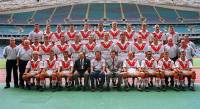 Grand Finalists 1999
Grand Finalists 1999
Dragons team, 1999 Grand Final
Luke PATTEN, Nathan BLACKLOCK,
Paul McGREGOR (c),
Shaun TIMMINS, Jamie AINSCOUGH, Anthony MUNDINE, Trent
BARRETT, Wayne BARTRIM, Lance THOMPSON, Darren TREACY, Craig SMITH (c), Nathan
BROWN, Chris LEIKVOLL
Interchange: Craig FITZGIBBON, Colin WARD, Brad MACKAY,
Rod WISHART.
Coaches: David WAITE & Andrew FARRAR |
| For
a more comprehensive list of highlights from every year since 1921, click
here | | |
 |
| | |







